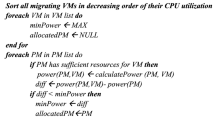Abstract
Over the past two years, the pandemic-induced demand for resources and services has accelerated. The paradigm of softwarization as well as webization, services, and network virtualization have caused disruptive changes within cloudified environments. Software services are the most crucial part of the evolution of these environments. So far, proprietary solutions are particularly emphasized owing to the current economic climate, such as the numerous cloud services that depend on commercial software. Thus, the ubiquity of this kind of software in the cloud creates a new dimension for software license (SL) optimization. For a prosperous company, optimal use of SL resources remains a capital and essential criterion. Managing these resources, virtualized hardware resources, energy, and costs generated in the cloud is a recent challenge. Although many consolidation strategies have been developed in the area of resource management to optimize standard resources and the resulting energy consumption, this problem remains topical despite optimization efforts. Indeed, appropriate schemes and models for the dynamic consolidation of resources and the optimization of data center states have always been under constant investigation and extensive study and development at the infrastructure level. But, so far, the software service level lacks models and algorithms that offer dynamic optimization of resource allocation and workload consolidation, especially when proprietary solutions are in hand. In this article, we offer suitable heuristics for dynamic software license consolidation (DSLC) and optimization of resources. These tend to reduce costs within a cloud data center and minimize overall power consumption. Our solutions allow us to optimize the monetary costs of the users and offer more flexibility to reduce the infrastructure costs. The experimental studies carried out from small to relatively big data centers, in both homogeneous and heterogeneous resource scenarios, show the efficiency of our solutions. Thus, we recorded a rate of 71.4% energy savings, 79.91% total cost savings, 80.25% license cost, and 76.5% virtual machine (VM) cost. We also highlighted a rate of 78% of deactivated physical machine (PMs) and 76.5% of released VMs.
Similar content being viewed by others
Data Availability
The datasets generated during and/or analyzed during the current study are available from the corresponding author on reasonable request.
References
Andrae, A.S., Edler, T.: On global electricity usage of communication technology: trends to 2030. Challenges 6, 117–157 (2015)
Bista, G., Caron, E., Vion, A.L.: A study on optimizing Vnf software cost. In: 2020 Global Information Infrastructure and Networking Symposium (GIIS), pp. 1–4. IEEE (2020)
Chowdhury, M.R., Mahmud, M.R., Rahman, R.M.: Implementation and performance analysis of various vm placement strategies in cloudsim. J. Cloud Comput. 4 (2015)
Chun, S.H.: Cloud services and pricing strategies for sustainable business models: Analytical and numerical approaches. Sustainability 12, 1–15 (2020)
Gao, Y., Guan, H., Qi, Z., Hou, Y., Liu, L.: A multi-objective ant colony system algorithm for virtual machine placement in cloud computing. J. Comput. Syst. Sci. 79, 1230–1242 (2013)
Helali, L., Brahmi, Z.: Self-organizing agents for dynamic network- and qos-aware service composition in cloud computing. In: Proceedings of 37th International Conference on Information Systems Architecture and Technology—ISAT 2016—Part II. Advances in Intelligent Systems and Computing, vol. 522, pp. 111–124. Springer, Cham (2017)
Helali, L., Omri, M.N.: A survey of data center consolidation in cloud computing systems. Comput. Sci. Rev. 39 (2021)
Höfer, C.N., Karagiannis, G.: Cloud computing services: taxonomy and comparison. J. Internet Serv. Appl. 2, 81–94 (2011)
Hussein, M.K., Mousa, M.H., Alqarni, M.A.: A placement architecture for a container as service (caas) in a cloud environment. J. Cloud Comput. (2019)
Karve, A., Kimbrel, T., Pacifici, G., Spreitzer, M., Steinder, M., Sviridenko, M., Tantawi, A.: Dynamic placement for clustered web applications. In: Proceedings of the 7th International Conference on World Wide Web (2006)
Khan, A.A., Zakarya, M., Khan, R., Rahman, I.U., Khan, M., Khan, A.u.R.: An energy, performance efficient resource consolidation scheme for heterogeneous cloud datacenters. J. Netw. Comput. Appl. 150 (2020)
Mann, Z.A.: Resource optimization across the cloud stack. IEEE Trans. Parallel Distrib. Syst. 29, 169–182 (2018)
Murthy, M.K.M., Ameen, M.N., Sanjay, H.A., Yasser, P.M.: Software licensing models and benefits in cloud environment: a survey. In: Kumar M.A., Selvarani, R., Kumar T. (eds.) Proceedings of International Conference on Advances in Computing. Advances in Intelligent Systems and Computing, vol. 174, pp. 645–650. Springer, New Delhi (2013)
Piraghaj, S.F.: Energy-efficient management of resources in container-based clouds. PhD Thesis, The University of Melbourne, Australia (2016)
Ramanathan, S., Kondepu, K., Zhang, T., Mirkhanzadeh, B., Razo, M., Tacca, M., Vi, L., Fumagalli, A.: A comprehensive study of virtual machine and container based core network components migration in openroadm sdn-enabled network. arXiv:2108.12509 (2021)
Sen, A., Garg, A., Verma, A., Nayak, T.: Cloudbridge: on integrated hardware-software consolidation. ACM SIGMETRICS Perform. Eval. Rev. 39 (2011)
Tchana, A., Palma, N.D., Safieddine, I., Hagimont, D.: Software consolidation as an efficient energy and cost saving solution. Futur. Gener. Comput. Syst. 58, 1–12 (2016)
Vion, A.L.: Software asset management and cloud computing. (Gestion Du Patrimoine Logiciel Et Cloud Computing) PhD Thesis, Grenoble Alpes University, France (2018)
Wu, C., Buyya, R., Ramamohanarao, K.: Cloud pricing models: taxonomy, survey, and interdisciplinary challenges. ACM Comput. Surv. 52, 108:1–108:36 (2020)
Yousefipour, A., Rahmani, A.M., Jahanshahi, M.: Energy and cost-aware virtual machine consolidation in cloud computing. Softw.: Pract. Exp. 48 (2018)
Zhang, R., Chen, Y., Dong, B., Tian, F., Zheng, Q.: A genetic algorithm-based energy-efficient container placement strategy in caas. IEEE Access 7, 121360–121373 (2019)
Author information
Authors and Affiliations
Corresponding author
Additional information
Publisher’s Note
Springer Nature remains neutral with regard to jurisdictional claims in published maps and institutional affiliations.
Appendix: The Numerical Results of our Model
Appendix: The Numerical Results of our Model
Rights and permissions
About this article
Cite this article
Helali, L., Omri, M.N. Software License Consolidation and Resource Optimization in Container-based Virtualized Data Centers. J Grid Computing 20, 13 (2022). https://doi.org/10.1007/s10723-022-09602-5
Received:
Accepted:
Published:
DOI: https://doi.org/10.1007/s10723-022-09602-5




